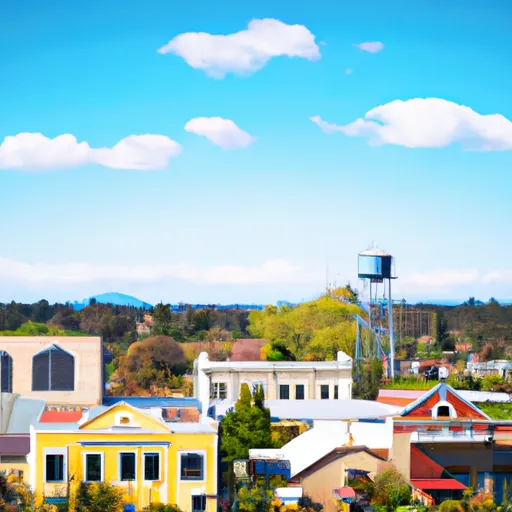-
 Snoflo Premium
Snoflo Premium
Get unlimited access to all our content
With no Ad interruptions! - Start Your Free Trial Login with existing account
La-Grange
Eden Index
Climate
9.3
•
Recreation
4.8
•
Community
•
Safeguard
5.4/10

La-Grange, California is a small town located in Stanislaus County. It experiences a Mediterranean climate with warm, dry summers and mild, wet winters. The average temperature in La-Grange ranges from 50°F (10°C) in winter to 90°F (32°C) in summer. Precipitation is highest during the winter months, with an annual average of around 15 inches (38 cm).
The town is situated near the Tuolumne River, which contributes to its hydrology constituents. The river not only provides a scenic backdrop but also offers various water-based activities like swimming, fishing, and boating.
In addition to water activities, La-Grange boasts several outdoor recreation opportunities. The surrounding area features beautiful hiking trails, perfect for nature lovers and hikers of all skill levels. Local parks offer picnic areas, playgrounds, and open spaces for family gatherings and relaxation. Moreover, the region is dotted with picturesque vineyards, providing a unique opportunity for wine tasting and vineyard tours.
Overall, La-Grange, California offers a pleasant Mediterranean climate, access to the Tuolumne River, and a range of outdoor activities for visitors and residents to enjoy throughout the year.
What is the Eden Index?
The Snoflo Eden Index serves as a comprehensive rating system for regions, evaluating their desirability through a holistic assessment of climate health, outdoor recreation opportunities, and natural disaster risk, acknowledging the profound impact of these factors on livability and well-being.
Climate Health Indicator (CHI): 9.3
La-Grange receives approximately
436mm of rain per year,
with humidity levels near 60%
and air temperatures averaging around
17°C.
La-Grange has a plant hardyness factor of
9, meaning
plants and agriculture in this region tend to thrive here all year round.
By considering the ideal temperature range, reliable water supplies, clean air, and stable seasonal rain or snowpacks, the Climate Health Indicator (CHI) underscores the significance of a healthy climate as the foundation for quality living.
A healthy climate is paramount for ensuring a high quality of life and livability in a region, fostering both physical well-being and environmental harmony. This can be characterized by ideal temperatures, reliable access to water supplies, clean air, and consistent seasonal rain or snowpacks.
Weather Forecast
Streamflow Conditions
San Joaquin
Area Rivers
San Joaquin
Snowpack Depths
San Joaquin
Reservoir Storage Capacity
San Joaquin
Groundwater Levels
Recreational Opportunity Index (ROI): 4.8
The Recreational Opportunity Index (ROI) recognizes the value of outdoor recreational options, such as parks, hiking trails, camping sites, and fishing spots, while acknowledging that climate plays a pivotal role in ensuring the comfort and consistency of these experiences.
Access to outdoor recreational opportunities, encompassing activities such as parks, hiking, camping, and fishing, is crucial for overall well-being, and the climate plays a pivotal role in enabling and enhancing these experiences, ensuring that individuals can engage in nature-based activities comfortably and consistently.
Camping Areas
| Campground | Campsites | Reservations | Toilets | Showers | Elevation |
|---|---|---|---|---|---|
| Frogtown RV Park | None | 1,544 ft | |||
| Manzanita - Tuttletown Area - New Melones Lake | 60 | 1,179 ft | |||
| Chamise - Tuttletown Area - New Melones Lake | 36 | 1,089 ft | |||
| Ironhorse- Glory Hole Area - New Melones Lake | 90 | 1,050 ft | |||
| Acorn - Tuttletown Area - New Melones Lake | 69 | 1,050 ft | |||
| Big Oak - Glory Hole Area - New Melones Lake | 55 | 1,050 ft | |||
| Tuttletown Rec Area - Chamise | 60 | 1,265 ft | |||
| McClure Point Rec Area | 100 | 920 ft | |||
| Lake McSwain Rec Area | 99 | 449 ft | |||
| Gloryhole Rec Area- Ironhorse - USBR | 300 | 1,172 ft |
Nearby Fishing
Nearby Ski Areas
Catastrophe Safeguard Index (CSI):
The Catastrophe Safeguard Index (CSI) recognizes that natural disaster risk, encompassing floods, fires, hurricanes, and tornadoes, can drastically affect safety and the overall appeal of an area.
The level of natural disaster risk in a region significantly affects safety and the overall livability, with climate change amplifying these risks by potentially increasing the frequency and intensity of events like floods, fires, hurricanes, and tornadoes, thereby posing substantial challenges to community resilience and well-being.
Community Resilience Indicator (CRI):
The Community Resilience Indicator (CRI) recognizes that education, healthcare, and socioeconomics are crucial to the well-being of a region. The CRI acknowledges the profound impact of these elements on residents' overall quality of life. By evaluating educational resources, healthcare accessibility, and economic inclusivity, the index captures the essential aspects that contribute to a thriving community, fostering resident satisfaction, equity, and social cohesion.

